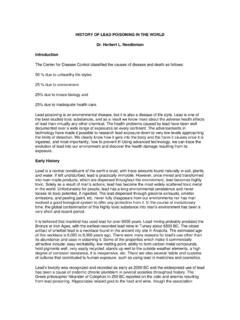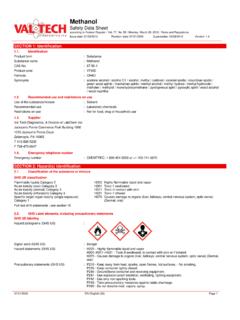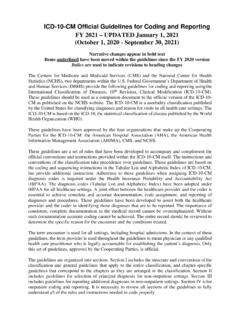Transcription of Documenting Diabetes Mellitus Under ICD-10
1 1 of 2 FPM Toolbox To find more practice resources, visit by Kenneth D. Beckman, MD, MBA, CPE, CPC. Copyright 2013 American Academy of Family Physicians. Physicians may duplicate or adapt for use in their own practices; all other rights reserved. Related article: ICD-10 , Diabetes Mellitus falls into five major categories. Three of these categories are rarely encountered in family medicine: E08, Diabetes due to underlying condition, is never used as a primary diagnosis. This category is reserved for indi-viduals who develop Diabetes Mellitus as the result of an underlying condition such as malignancy, malnutrition, and pancreatitis. E09, Drug or chemical induced Diabetes Mellitus , will not be encountered often in primary care.
2 When it is, the provider would first code the poisoning due to a drug or toxin, use additional codes for adverse effects when appli-cable, and use the fourth through seventh characters to list complications. E13, Other specified Diabetes Mellitus , is another cat-egory that is rarely used in primary care. This category includes Diabetes Mellitus due to genetic defects of beta-cell function and insulin action. It also includes postpro-cedural Diabetes Mellitus including postpancreatectomy Diabetes Mellitus . The two categories common in family medicine are E10, Type 1 Diabetes Mellitus , and E11, Type 2 Diabetes Mellitus . To docu-ment these conditions for ICD-10 coding, a provider would need to take the following steps:1. Specify Type 1 or Type 1 Diabetes Mellitus includes: Brittle Diabetes Mellitus , Diabetes Mellitus due to autoimmune process, Diabetes Mellitus due to immune mediated pancreatic islet beta-cell destruction, Idiopathic Diabetes Mellitus , Juvenile onset Diabetes Mellitus , Ketosis-prone Diabetes 2 Diabetes Mellitus includes: Diabetes Mellitus due to insulin secretory defect, Diabetes not otherwise specified, Insulin resistant Diabetes Document the degree of eliminates any reference to controlled and not con-trolled.
3 However, the codes shown below include with hypogly-cemia and with hyperglycemia. Although your patient may have Type 2 Diabetes Mellitus with-out complications ( ), the patient may have elevated blood sugars or an elevated A1C. In this situation, it might be more accurate to code Type 2 Diabetes Mellitus with hyperglycemia ( ). ICD-10 does not currently define hyperglycemia, but it considers hyperglycemia to be a complication of Diabetes , which is why code is found in the code family for Type 2 Diabetes Mellitus with other specified complications. Of course, Diabetes with a complication code carries a relatively higher ill-ness burden than Diabetes without a complication code. Unfortunately, until the final version of ICD-10 is published, it is unknown whether the term hyperglycemia will be Specify insulin use.
4 The primary codes for Diabetes Mellitus do not include whether the individual is using insulin. Therefore, you must use a second ICD-10 code: , Long term (current) insulin use. Unfortunately, long term does not necessarily mean long term. The long term use code for any drug is appropriate once that drug has been started. If you prescribe insulin for the first time at an office visit, it is appropriate to add the code to the base Diabetes Mellitus code you are Specify complications to a very specific additional characters in the Diabetes codes are essentially the same for both Type 1 (E10) and Type 2 (E11). The list of Type 2 codes, below, shows the degree of specificity required. It is important to note the specific wording of each diagnosis code.
5 For instance, if your patient has Diabetes Mellitus and chronic kidney disease, you need to specify cause and effect for the con-dition to be properly Type 2 Diabetes Mellitus with hyperosmolarity .. without nonketotic hyperglycemic hyperosmolar coma .. with Type 2 Diabetes Mellitus with kidney complications .. with diabetic nephropathy .. with diabetic chronic kidney disease .. with other diabetic kidney complicationDOCUMENTING Diabetes Mellitus Under ICD-10continued Documenting Diabetes Mellitus Under ICD-10 2 OF Type 2 Diabetes Mellitus with ophthalmic complications .. with unspecified diabetic retinopathy .. with macular edema .. without macular edema .. with mild nonproliferative diabetic retinopathy.
6 With macular edema .. without macular edema .. with moderate nonproliferative diabetic retinopathy .. with macular edema .. without macular edema .. with severe nonproliferative diabetic retinopathy .. with macular edema .. without macular edema .. with proliferative retinopathy .. with macular edema .. without macular edema .. with diabetic cataract .. with other diabetic ophthalmic Type 2 Diabetes Mellitus with neurologic complications .. with diabetic neuropathy, unspecified .. with diabetic mononeuropathy .. with diabetic polyneuropathy .. with diabetic autonomic (poly)neuropathy .. with diabetic amyotrophy .. with other diabetic neurological Type 2 Diabetes Mellitus with circulatory complications.
7 With diabetic peripheral angiopathy without gangrene .. with diabetic peripheral angiopathy with gangrene .. with other circulatory Type 2 Diabetes Mellitus with other specified complications .. with diabetic arthropathy .. with diabetic neuropathic arthropathy .. with other diabetic arthropathy .. with skin complications .. with diabetic dermatitis .. with foot ulcer .. with other skin ulcer .. with other skin complications .. with oral complications .. with periodontal disease .. with other oral complications .. with hypoglycemia .. with coma .. without coma .. with hyperglycemia .. with other specified Type 2 Diabetes Mellitus with unspecified Type 2 Diabetes Mellitus without complicationsAs you can see from these examples, there are numerous codes that document the type of Diabetes , the severity of the condi-tion, and the complications of the disease.
8 Adding to the dif-ficulty, when the patient has multiple complications, correct coding requires you to document and code each complication good news is that, in family medicine, there are a limited number of ICD-10 codes that will describe the majority of your patients with Type 2 Type 2 Diabetes Mellitus without Type 2 Diabetes Mellitus with Type 2 Diabetes Mellitus with hypoglycemia without Type 2 Diabetes Mellitus with mild nonproliferative diabetic retinopathy without macular Type 2 Diabetes Mellitus with diabetic chronic kidney Type 2 Diabetes Mellitus with diabetic Long term (current) insulin useWhile it may be tempting to list these seven codes on your superbill and think that s sufficient, it is important that you remember to thoroughly document each patient s specific con-dition so that coders may accurately code those patients with additional complications that aren t listed on your is also important to remember to code all additional diagno-ses.
9 As family physicians, we know that our patients who have Diabetes often also have hypertension, hyperlipidemia, and obesity and may use tobacco products. Each of these additional issues requires separate coding. These additional diagnostic codes may have almost as many combinations as found in the Diabetes Mellitus codes.



















